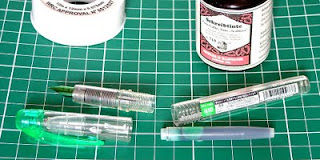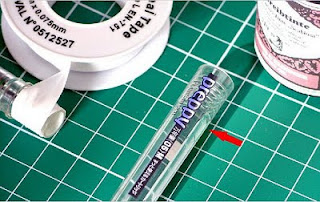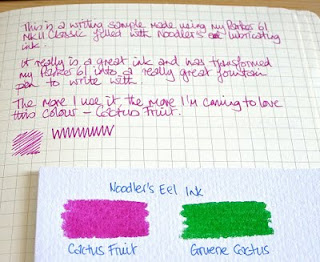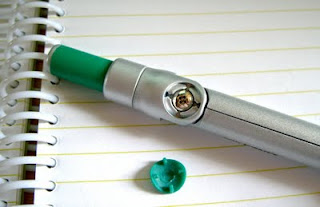I've been meaning to have a go at making an eyedropper-fill fountain pen for a while, ever since seeing similar pens on the blogs Unposted and Good Pens however, events have been conspiring to prevent me from having a go, namely:
a) My Preppy would just not run out of ink!
b) Locating plumbers' silicon grease in the UK has proved extremely difficult and,
c) I couldn't think what to replace the grease with until...
It was one of those 'Eureka' moments - what do UK plumbers use in place of the grease? PTFE tape, that's what! A quick trip to my local DIY barn and I've now armed myself with a roll of the stuff for just a couple of pounds; and the Preppy has finally run out of ink.
PTFE tape - also known as 'Teflon tape', 'Thread seal tape', or 'plumber's tape' is a polytetrafluoroethylene (PTFE) film cut to specified widths for use in sealing pipe threads. The tape is wrapped around the exposed threads of a pipe before it is screwed into place. Since the PTFE is malleable, deformable and impermeable, it acts a little like putty under compression, being forced into small gaps between threads in order to create an air- and watertight seal when threaded into a joint.
I was also hanging on as I've got this ink I want to test, but as it's an iron gall ink and I've read all sorts of horror stories about what iron gall inks can do to the insides of your favourite fountain pen, I was determined to wait and test the ink in something potentially disposable.
Well, here we are at last - a Platinum Preppy 0.3mm eyedropper fill using PTFE tape and filled with Rohrer & Klingner Scabiosa ink. I'll discuss the ink shortly, first here's how I made the pen...
Should you decide to have a go at this conversion, you will need:
a) A suitable donor fountain pen, such as a Preppy
b) A roll of PTFE tape
c) A syringe or eyedropper, and
d) Ink of your choice
Step 1

Unless yours is a new (or previously cleaned) pen, remove the cartridge or filler and put to one side, we won't be needing them again.
Step 2

After ensuring your pen is thoroughly clean and dry, take the PTFE tape and wind tightly, but not too tightly, around the threads of the nib section a few times. Maintain the tension while you're doing this to ensure the tape sits well in the grooves of the threads - not too tight though, or the tape will stretch and wrinkle and may not form an ink-tight seal.
Step 3

'The Water Test' - if you know your way around PTFE tape, you can skip this step, other wise fill the barrel of your pen with water (ordinary tap water will suffice for the test) to just below the start of the threaded part (indicated by the red arrow in the photograph above). Assemble the pen and test for leaks. Depending on which pen you are using, somewhere between three to six turns of tape should provide a watertight seal.
It is worth mentioning that the tape should be wound anti-clockwise (with the nib facing to the left) so it remains smooth when the pen is screwed back together - wind it clockwise and it'll bunch up into an almighty mess when you try putting the pen back together!
Any time you re-fill the pen it is worth replacing the tape.
Step 4

Presuming the water test was successful, repeat steps 2 and 3, though this time fill with the ink of your choice.
Now I've got the pen working, let's talk a bit about the ink...
Rohrer & Klingner of Leipzig, Germany, has been manufacturing lithographic products since 1892, and now makes a range of eighteen tones of fountain pen ink, details of which can be found here. In the UK, Rohrer & Klingner inks are available from The Writing Desk, colour swatches of the range can be seen here; two inks in the range, Scabiosa and Salix are iron gall inks.
Stayed tuned folks, here comes the history/science bit...
Iron gall ink was traditionally made by combining tannic acid from oak galls with vitriol and gum arabic. It was the ink of choice during medieval times and was still in widespread use up to the middle of the twentieth century. Iron gall made a perfect travelling ink as the ingredients could be mixed dry and water added only when necessary. It was also indelible and difficult to remove from the writing surface, making it ideal for official documents.
Traditional iron gall ink starts out as a pale grey solution, which darkens gradually to an intense purplish-black on contact with oxygen. Rohrer & Klingner Scabiosa is a delicate shade of purple, somewhat reminiscent of Diamine Damson. In my tests it tend to come out of the pen as a pale purplish-lavender, then darkens to a rich purple as it dries. There is a small amount of shading even with a fine nib, though I imagine much more shading would be possible with a wider or flex nib.

All in all I've been very pleased with this pen and ink combination, and have yet to notice any adverse effects to the Preppy from the iron gall ink. Over the past week there has been a small amount of ink-creep along the threads, though the PTFE seal has held so far. I daresay a few more turns of tape will cure that, so things are looking good for a more long-term test.
At a Glance:
Pen: Preppy available from JetPens in the US, Cult Pens in the UK
Price: JetPens $3.00; CultPens £3.99
Ink: Rohrer & Klingner ink available from The Writing Desk in the UK
Price: £3.90 per 50ml bottle.
Tape: PTFE tape available from all good DIY stores in the UK
Price: £1 - 2
Overall: 4* out of 5
* until I completely cure the ink creep.
You may have noticed the Preppy in some of the photos is not the 03mm nib version mentioned in the text, the original pen was in use when the pics were taken, which necessitated the use of its stunt double, my 0.5mm Preppy! ;)







































